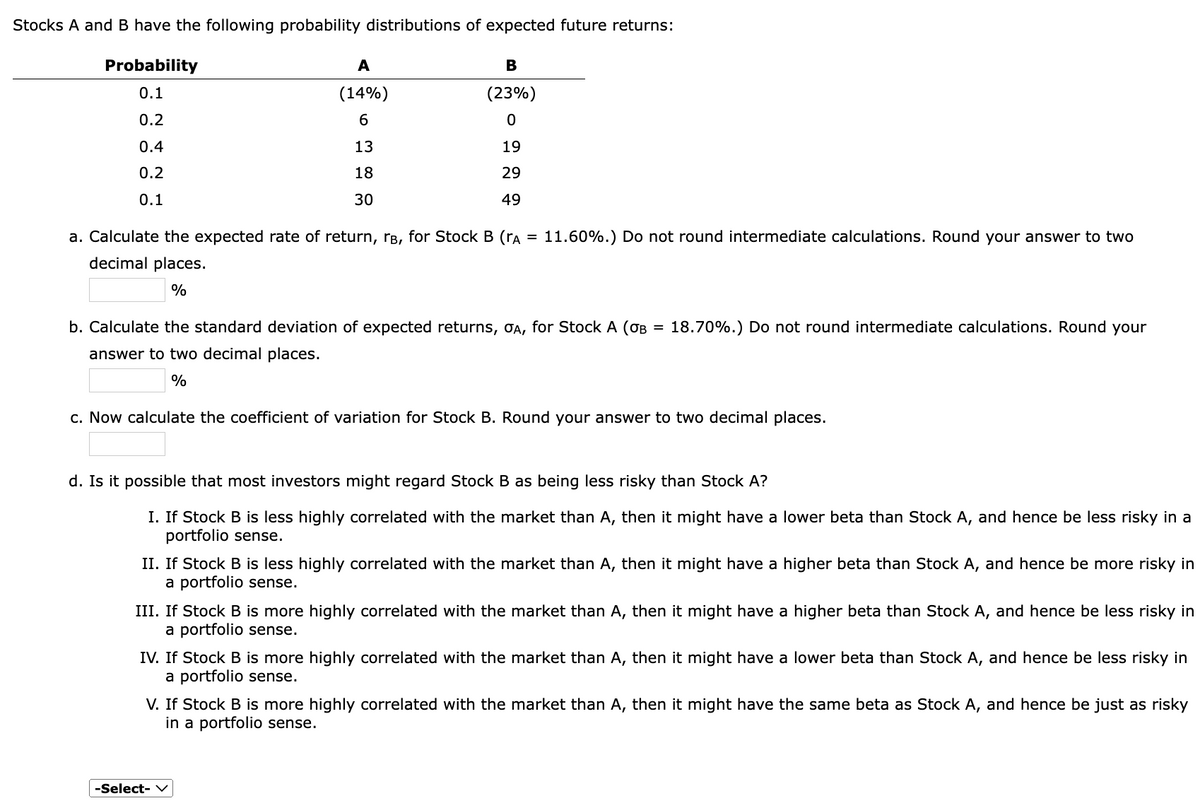Stocks A and B have the following probability distributions of expected future returns: Probability 0.1 0.2 0.4 0.2 0.1 A (14%) 6 13 18 30 B (23%) 0 19 29 49 a. Calculate the expected rate of return, rB, for Stock B (rA = 11.60%.) Do not round intermediate calculations. Round your answer to two decimal places. % b. Calculate the standard deviation of expected returns, OA, for Stock A (OB = 18.70%.) Do not round intermediate calculations. Round your answer to two decimal places. % c. Now calculate the coefficient of variation for Stock B. Round your answer to two decimal places. d. Is it possible that most investors might regard Stock B as being less risky than Stock A? I. If Stock B is less highly correlated with the market than A, then it might have a lower beta than Stock A, and hence be less risky in a portfolio sense. II. If Stock B is less highly correlated with the market than A, then it might have a higher beta than Stock A, and hence be more risky in a portfolio sense. III. If Stock B is more highly correlated with the market than A, then it might have a higher beta than Stock A, and hence be less risky in a portfolio sense. IV. If Stock B is more highly correlated with the market than A, then it might have a lower beta than Stock A, and hence be less risky in a portfolio sense. -Select- ✓ V. If Stock B is more highly correlated with the market than A, then it might have the same beta as Stock A, and hence be just as risky in a portfolio sense.
Stocks A and B have the following probability distributions of expected future returns: Probability 0.1 0.2 0.4 0.2 0.1 A (14%) 6 13 18 30 B (23%) 0 19 29 49 a. Calculate the expected rate of return, rB, for Stock B (rA = 11.60%.) Do not round intermediate calculations. Round your answer to two decimal places. % b. Calculate the standard deviation of expected returns, OA, for Stock A (OB = 18.70%.) Do not round intermediate calculations. Round your answer to two decimal places. % c. Now calculate the coefficient of variation for Stock B. Round your answer to two decimal places. d. Is it possible that most investors might regard Stock B as being less risky than Stock A? I. If Stock B is less highly correlated with the market than A, then it might have a lower beta than Stock A, and hence be less risky in a portfolio sense. II. If Stock B is less highly correlated with the market than A, then it might have a higher beta than Stock A, and hence be more risky in a portfolio sense. III. If Stock B is more highly correlated with the market than A, then it might have a higher beta than Stock A, and hence be less risky in a portfolio sense. IV. If Stock B is more highly correlated with the market than A, then it might have a lower beta than Stock A, and hence be less risky in a portfolio sense. -Select- ✓ V. If Stock B is more highly correlated with the market than A, then it might have the same beta as Stock A, and hence be just as risky in a portfolio sense.
Chapter8: Analysis Of Risk And Return
Section: Chapter Questions
Problem 12P
Related questions
Question
Finance

Transcribed Image Text:Stocks A and B have the following probability distributions of expected future returns:
Probability
0.1
0.2
0.4
0.2
0.1
A
(14%)
6
13
18
30
B
(23%)
0
19
29
49
=
a. Calculate the expected rate of return, rå, for Stock B (rA
decimal places.
%
11.60%.) Do not round intermediate calculations. Round your answer to two
=
b. Calculate the standard deviation of expected returns, σA, for Stock A (OB
answer to two decimal places.
%
18.70%.) Do not round intermediate calculations. Round your
c. Now calculate the coefficient of variation for Stock B. Round your answer to two decimal places.
d. Is it possible that most investors might regard Stock B as being less risky than Stock A?
I. If Stock B is less highly correlated with the market than A, then it might have a lower beta than Stock A, and hence be less risky in a
portfolio sense.
II. If Stock B is less highly correlated with the market than A, then it might have a higher beta than Stock A, and hence be more risky in
a portfolio sense.
-Select-
III. If Stock B is more highly correlated with the market than A, then it might have a higher beta than Stock A, and hence be less risky in
a portfolio sense.
IV. If Stock B is more highly correlated with the market than A, then it might have a lower beta than Stock A, and hence be less risky in
a portfolio sense.
V. If Stock B is more highly correlated with the market than A, then it might have the same beta as Stock A, and hence be just as risky
in a portfolio sense.
Expert Solution
This question has been solved!
Explore an expertly crafted, step-by-step solution for a thorough understanding of key concepts.
Step by step
Solved in 3 steps with 1 images

Knowledge Booster
Learn more about
Need a deep-dive on the concept behind this application? Look no further. Learn more about this topic, finance and related others by exploring similar questions and additional content below.Recommended textbooks for you

EBK CONTEMPORARY FINANCIAL MANAGEMENT
Finance
ISBN:
9781337514835
Author:
MOYER
Publisher:
CENGAGE LEARNING - CONSIGNMENT

Intermediate Financial Management (MindTap Course…
Finance
ISBN:
9781337395083
Author:
Eugene F. Brigham, Phillip R. Daves
Publisher:
Cengage Learning


EBK CONTEMPORARY FINANCIAL MANAGEMENT
Finance
ISBN:
9781337514835
Author:
MOYER
Publisher:
CENGAGE LEARNING - CONSIGNMENT

Intermediate Financial Management (MindTap Course…
Finance
ISBN:
9781337395083
Author:
Eugene F. Brigham, Phillip R. Daves
Publisher:
Cengage Learning

